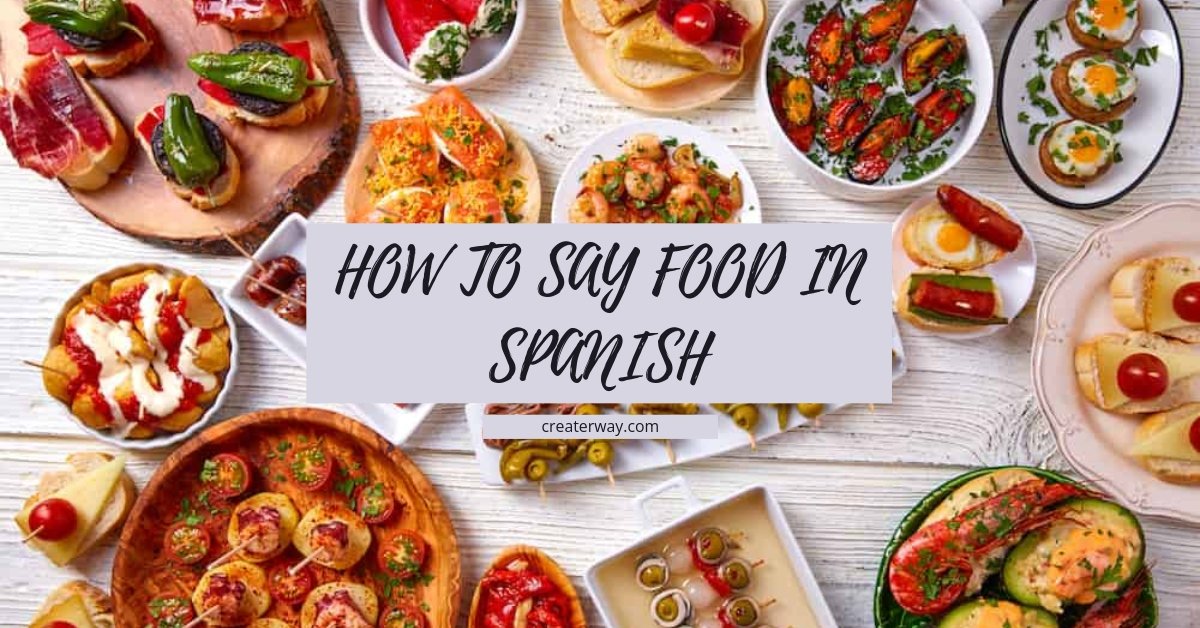FOOD
HOW TO SAY FOOD IN SPANISH

HOW TO SAY FOOD IN SPANISH? When it comes to learning a new language, one of the essential aspects is acquiring vocabulary related to food. Food is a central part of the culture in Spanish-speaking countries, and knowing the names of different dishes and ingredients can greatly enhance your experience. This article will provide a comprehensive guide on how to say food in Spanish, covering various categories, popular dishes, and essential vocabulary related to food.
Nouns for Food and Ingredients:
HOW TO SAY FOOD IN SPANISH?
Fruits and Vegetables:
- Frutas y Verduras:
Learn the names of commonly consumed fruits and vegetables, such as manzana (apple), plátano (banana), zanahoria (carrot), and lechuga (lettuce).
Meats and Seafood:
- Carnes y Mariscos:
Explore the vocabulary for different types of meats and seafood, including pollo (chicken), cerdo (pork), Camarones (shrimp), and Pescado (fish).
Grains and Legumes:
- Granos y Legumbres:
Discover the names of various grains and legumes like arroz (rice), trigo (wheat), lentejas (lentils), and frijoles (beans).
Dairy Products:
- Productos Lácteos:
Familiarize yourself with the Spanish words for dairy products like Leche (milk), queso (cheese), mantequilla (butter), and you’re (yogurt).
Food Preparation Techniques:
Cooking Methods:
- Métodos de Cocina:
Learn the terms for different cooking techniques, such as asar (to roast), hervir (to boil), freír (to fry), and hornear (to bake).
Food Presentation:
- Presentación de Alimentos:
Understand how to describe various food presentations, including al vapor (steamed), a la parrilla (grilled), en ensalada (in salad), y en rodajas (sliced).
Traditional Spanish Dishes:
Tapas:
- Tapas:
Explore the world of tapas, small savory dishes often served with drinks. Discover classic tapas such as patatas bravas (spicy potatoes), tortilla española (Spanish omelet), and pulpo a la gallega (Galician-style octopus).
Paella:
- Paella:
Dive into the iconic Spanish dish, paella, a saffron-infused rice dish typically prepared with seafood, meat, or vegetables. Learn the names of ingredients like arroz (rice), pollo (chicken), mariscos (seafood), and pimiento (bell pepper).
Gazpacho:
- Gazpacho:
Discover the refreshing cold soup made from blended vegetables, typically tomatoes, cucumbers, peppers, and garlic. Learn the vocabulary for ingredients such as tomate (tomato), pepino (cucumber), ajo (garlic), and aceite de oliva (olive oil).
Ordering Food in Spanish:
Dining Out:
- Comer Fuera:
Learn essential phrases when dining out, including ¿Me puede traer la carte? (Can you bring me the menu?), Quisiera hacer una reserva (I would like to make a reservation), and ¿Cuál es la especialidad de la casa? (What is the specialty of the house?).
Food Allergies and Preferences:
- Alergias Alimentarias y Preferencias:
Understand how to communicate your food allergies and preferences in Spanish, such as Soy alérgico/a los frutos secos (I am allergic to nuts), No como carne (I don’t eat meat), or Quisiera una opción vegetariana (I would like a vegetarian option).
Expressing Likes and Dislikes:
- Expresar Gustos y Disgustos:
Learn phrases to express your likes and dislikes regarding food, such as Me encanta el chocolate (I love chocolate), No me gusta el pescado (I wouldn’t say I like to fish), or Prefiero la comida picante (I prefer spicy food).
Exploring Local Markets and Grocery Shopping:
Local Markets:
- Mercados Locales:
Discover the vibrant atmosphere of local markets and learn useful vocabulary to navigate them. Words like Mercado (market), vendor (vendor), frutas frescas (fresh fruits), and panadería (bakery) will come in handy.
Grocery Shopping:
- Compras de Supermercado:
Familiarize yourself with the vocabulary needed for grocery shopping, such as lista de compras (shopping list), carrito de compras (shopping cart), productos lácteos (dairy products), and products enlatados (canned goods).
Regional Cuisine:
Mexican Cuisine:
- Gastronomía Mexicana:
Dive into Mexican cuisine’s rich and diverse world, from tacos and enchiladas to guacamole and mole. Learn popular ingredients like tortillas, jalapeños, aguacate (avocado), and frijoles refritos (refried beans).
Argentinean Cuisine:
- Gastronomía Argentina:
Explore the flavors of Argentinean cuisine, known for its succulent steaks, empanadas, and mate tea. Discover words like carne asada (grilled meat), chimichurri, dulce de leche (caramel), and alfajores.
Sweet Treats:
Churros:
- Churros:
Indulge in the delightful Spanish treat, churros, long fried dough pastries usually dipped in thick hot chocolate. Learn how to order churros and describe them using words like azúcar (sugar), crujiente (crispy), and Caliente (hot).
Flan:
- Flan:
Delve into the world of flan, a creamy caramel custard dessert popular in many Spanish-speaking countries. Discover words like leche condensada (condensed milk), caramelo (caramel), huevos (eggs), and vainilla (vanilla).

